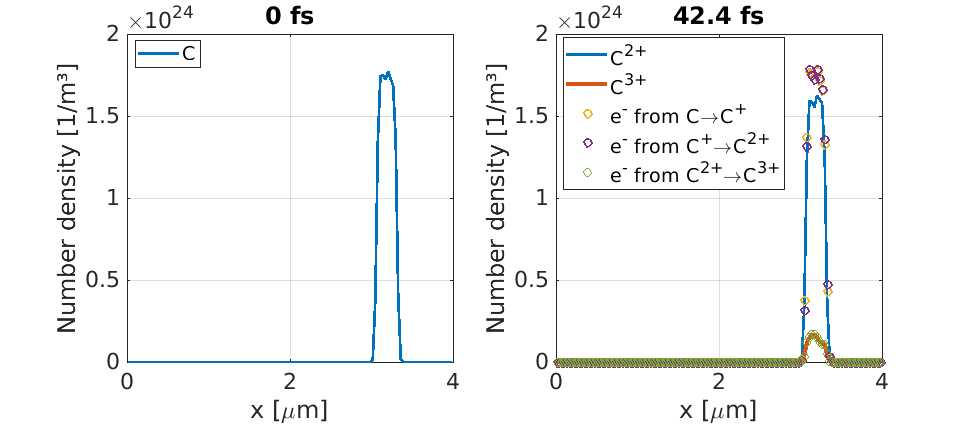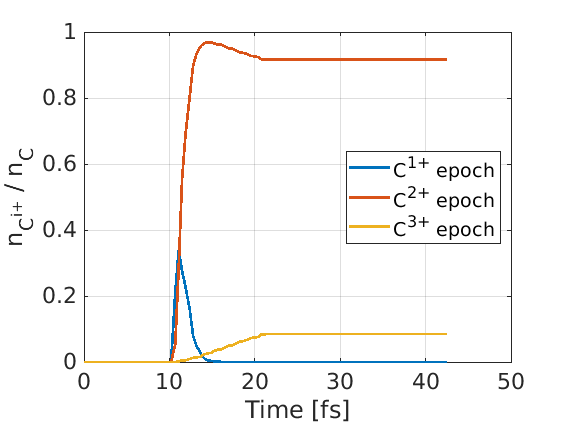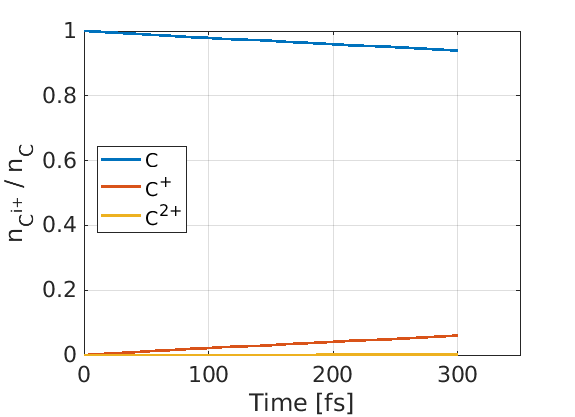Ionisation
Particles within an EPOCH simulation have the option to be ionised through either field ionisation, or electron-impact collisional ionisation. The keys required to set up ionisation are found in multiple blocks, and a summary may be found in the species block documentation. This page provides simple demos for the ionisation packages.
In general, the user defines an initial ion species, and the code automatically generates species for the ionised states. During ionisation, a bound electron is released from an ion, and added to an electron species as a macro-particle.
Field ionisation
In field ionisation, ions are created in the presence of strong laser fields. In
this 1D input deck, a laser moves from the x_min boundary towards a block of
neutral carbon. EPOCH can identify the ion species as neutral carbon, as the
charge and atomic_no have been specified in the
species block.
The species
block also tells EPOCH that the Carbon species can be ionised since the
ionise = T line is provided. The number of possible ionisation states has been
manually cut-off at 3 by the ionise_limit key. When an ionisation occurs, a
new macro-electron is generated and assigned to a species which will be
automatically generated, as specified by unique_electron_species = T.
Once the ionisation keys in the species block have been activated, we need to
tell EPOCH what kind of ionisation should occur. Here, we switch on the field
ionisation process using the
control block key
field_ionisation.
begin:control
nx = 128
npart = 20 * nx
t_end = 42.4e-15
x_min = 0
x_max = 4.0e-6
field_ionisation = T
end:control
begin:boundaries
bc_x_min = simple_laser
bc_x_max = open
end:boundaries
begin:laser
boundary = x_min
intensity = 3.0e15 * 1.0e4
lambda = 800.0e-9
t_profile = 1
t_end = 10.7e-15
end:laser
begin:species
name = Carbon
charge = 0
atomic_no = 6
mass = 1836.2 * 16.0
frac = 1
rho = if ((x lt 3.30e-6) and (x gt 3.05e-6), 1.74e24, 0)
ionise = T
ionise_limit = 3
unique_electron_species = T
end:species
begin:output
dt_snapshot = t_end/100
number_density = always + species
end:output
Once the input.deck directory has been selected, EPOCH prints:
Name of species 1 is Carbon
Name of species 2 is Carbon1
Name of species 3 is electron_from_Carbon
Name of species 4 is Carbon2
Name of species 5 is electron_from_Carbon1
Name of species 6 is Carbon3
Name of species 7 is electron_from_Carbon2
Initial conditions complete and valid.
Redistributing. Balance: 0.254, after: 0.507 (pre-load balance)
Attempting to load particles
Loaded 2560 particles of species "Carbon"
Here we see that although only one species is present in the input.deck, EPOCH
has generated species for Carbon with charge-states 1-3. If we had not included
ionise_limit, we would have generated species up to fully ionised Carbon.
Also, by setting unique_electron_species = T, the code has generated species
for electrons released by specific ions during ionisation. We also see no
macro-particles have been initially loaded into these automatically generated
species, as only Carbon has a specified density in the input.deck.
Once the simulation is complete, we can plot the number densities of each species at different times. As can be seen below, the system originally starts with only neutral carbon present, but ends with carbon ions of charge-state 2 and 3 after illumination by the laser.

We can also plot the fraction of carbon ions in each charge-state as a function of time:

Collisional ionisation
In collisional ionisation, ions undergo ionisation through collisions with electrons. In this simulation, the domain is filled with an equal number of electrons and neutral carbon atoms, and collisional ionisation between the two species generates carbon ions and ejected electrons.
As in the field ionisation example, the Carbon species uses
ionise = T to identify the species as one which can ionise. Without
ionise_limit, we allow ionisation up to fully-ionised carbon. In this example,
we create an empty electron species Ejected_electron, which will be used to
store macro-electrons which are ejected from ions during ionisation.
As collisional ionisation refers to ionisation when electrons hit ions, the code
needs to know which species are electron species. For the Electron_beam
species, the line identify:electron tells EPOCH the species can trigger
collisional ionisation. Also, EPOCH knows Ejected_elctron is an electron
species, because it is identified as a species to populate with electrons
ejected in the ionisation process from carbon ions.
Collisional ionisation is switched on using the collisional_ionisation=T line
in the
collisions block.
Note that this does not switch on Coulomb scatter collisions between species, as
this is a separate process from collisional ionisation.
begin:control
nx = 128
npart = 200 * nx
t_end = 300.0e-15
x_min = 0
x_max = 4.0e-6
end:control
begin:boundaries
bc_x_min = periodic
bc_x_max = periodic
end:boundaries
begin:collisions
collisional_ionisation = T
end:collisions
begin:species
name = Electron_beam
frac = 0.5
rho = 2.0e24
temp_ev = 80
identify:electron
end:species
begin:species
name = Carbon
charge = 0
atomic_no = 6
mass = 1836.2 * 16.0
frac = 0.5
rho = 2.0e24
ionise = T
electron_species = Ejected_electron
end:species
begin:species
name = Ejected_electron
frac = 0
charge = -1
mass = 1
end:species
begin:output
dt_snapshot = t_end/100
number_density = always + species
end:output
When we run this simulation, EPOCH prints the lines:
Name of species 1 is Electron_beam
Name of species 2 is Carbon
Name of species 3 is Ejected_electron
Name of species 4 is Carbon1
Name of species 5 is Carbon2
Name of species 6 is Carbon3
Name of species 7 is Carbon4
Name of species 8 is Carbon5
Name of species 9 is Carbon6
where the ionisation species Carbon1-Carbon6 have been automatically generated. Initially these ionised carbon particle species contain no macro-particles.
This simulation generates some Carbon1 ions and a small number of Carbon2. The collisional ionisation cross section is too low here to ionise to the higher charge states. A plot of the population fraction over time is given here:
